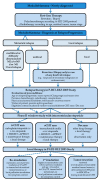Local and Systemic Therapy of Recurrent Medulloblastomas in Children and Adolescents: Results of the P-HIT-REZ 2005 Study
- PMID: 35158738
- PMCID: PMC8833340
- DOI: 10.3390/cancers14030471
Local and Systemic Therapy of Recurrent Medulloblastomas in Children and Adolescents: Results of the P-HIT-REZ 2005 Study
Abstract
Recurrent medulloblastomas are associated with survival rates <10%. Adequate multimodal therapy is being discussed as having a major impact on survival. In this study, 93 patients with recurrent medulloblastoma treated in the German P-HIT-REZ 2005 Study were analyzed for survival (PFS, OS) dependent on patient, disease, and treatment characteristics. The median age at the first recurrence was 10.1 years (IQR: 6.9-16.1). Median PFS and OS, at first recurrence, were 7.9 months (CI: 5.7-10.0) and 18.5 months (CI: 13.6-23.5), respectively. Early relapses/progressions (<18 months, n = 30/93) found mainly in molecular subgroup 3 were associated with markedly worse median PFS (HR: 2.34) and OS (HR: 3.26) in regression analyses. A significant survival advantage was found for the use of volume-reducing surgery as well as radiotherapy. Intravenous chemotherapy with carboplatin and etoposide (ivCHT, n = 28/93) showed improved PFS and OS data and the best objective response rate (ORR) was 66.7% compared to oral temozolomide (oCHT, n = 47/93) which was 34.8%. Intraventricular (n = 43) as well as high-dose chemotherapy (n = 17) at first relapse was not related to a significant survival benefit. Although the results are limited due to a non-randomized study design, they may serve as a basis for future treatment decisions in order to improve the patients' survival.
Keywords: chemotherapy; children; intraventricular therapy; medulloblastoma; radiotherapy; re-irradiation; recurrent; refractory; surgery.
Conflict of interest statement
The authors declare no conflict of interest. The funders had no role in the design of the study; in the collection, analyses, or interpretation of data; in the writing of the manuscript; or in the decision to publish the results.
Figures








References
-
- Hill R.M., Richardson S., Schwalbe E.C., Hicks D., Lindsey J.C., Crosier S., Rafiee G., Grabovska Y., Wharton S.B., Jacques T.S., et al. Time, pattern, and outcome of medulloblastoma relapse and their association with tumour biology at diagnosis and therapy: A multicentre cohort study. Lancet Child Adolesc. Health. 2020;4:865–874. doi: 10.1016/S2352-4642(20)30246-7. - DOI - PMC - PubMed
-
- Levy A.S., Krailo M., Chi S., Villaluna D., Springer L., Williams-Hughes C., Fouladi M., Gajjar A. Temozolomide with irinotecan versus temozolomide, irinotecan plus bevacizumab for recurrent medulloblastoma of childhood: Report of a COG randomized Phase II screening trial. Pediatr. Blood Cancer. 2021;68:e29031. doi: 10.1002/pbc.29031. - DOI - PMC - PubMed
-
- Gajjar A., Robinson G.W., Smith K.S., Lin T., Merchant T.E., Chintagumpala M., Mahajan A., Su J., Bouffet E., Bartels U., et al. Outcomes by Clinical and Molecular Features in Children With Medulloblastoma Treated With Risk-Adapted Therapy: Results of an International Phase III Trial (SJMB03) J. Clin. Oncol. 2021;39:822–835. doi: 10.1200/JCO.20.01372. - DOI - PMC - PubMed
Grants and funding
LinkOut - more resources
Full Text Sources

